HiFiMan took a risk by ignoring the status quo for shape, style, and technology – and it paid off.
- An elegant integrated headphone stand
- Powerful and dynamic sound
- Dual-mono R2R DAC
- Flexible and generous set of inputs and outputs
- Small desktop footprint
- Build quality concerns
- No front panel power switch
- No 4.4mm balanced port – 6.35 + XLR only
- Shape may not work on all desks
HiFiMan has become synonymous with great-sounding, affordable, full-sized, planar magnetic headphones. You may not know since the company’s early days, they have championed another alternative technology, R-2R DACs.
R-2R (or resistor ladder) DACs are more costly and complicated to implement than typical delta-sigma (D-S) chipset-based designs. They typically have worse objective measurements and can add distortion to the audio chain. Yet, they have an avid following among audiophiles, and much like vinyl, aficionados claim they are ‘analog,’ ‘tube-like,’ and ‘musical’ sounding.
Irrefutably, HiFiMan has been incredibly successful in the proliferation of planar magnetic headphone technology, and undaunted by a slower commercial uptake, they keep advancing their Himalaya series of R-2R DACs.
The current lineup of HiFiMan desktop DACs and amps featuring their R-2R tech include the EF400, EF500, EF600, and (the eye-wateringly expensive ~USD$15,000) EF1000. Today, we will look at the (much more reasonably priced sub-USD$700) EF600, which, from first glance, is clearly unusual in more ways than one.
One Minute Review Video
Design and Build
The traditional horizontal box design of audio equipment is slowly fading. Rather than merely finding a simple aluminum case to contain a circuit board with a few buttons on the front and ports on the back, manufacturers are rethinking design standards and changing what we should expect.
The somewhat PS5-shaped EF600 is a polarizing design that may suit your needs brilliantly or not work at all in your space. Vertically oriented, brushed silver aluminum front and rear plates sandwich a sculpted black plastic middle section shaped to function as a headphone stand. Smart.
The unique design means it has a smaller-than-average desktop footprint (around 105x165mm) but requires far more vertical space (285mm) than a traditional DAC/amp design.
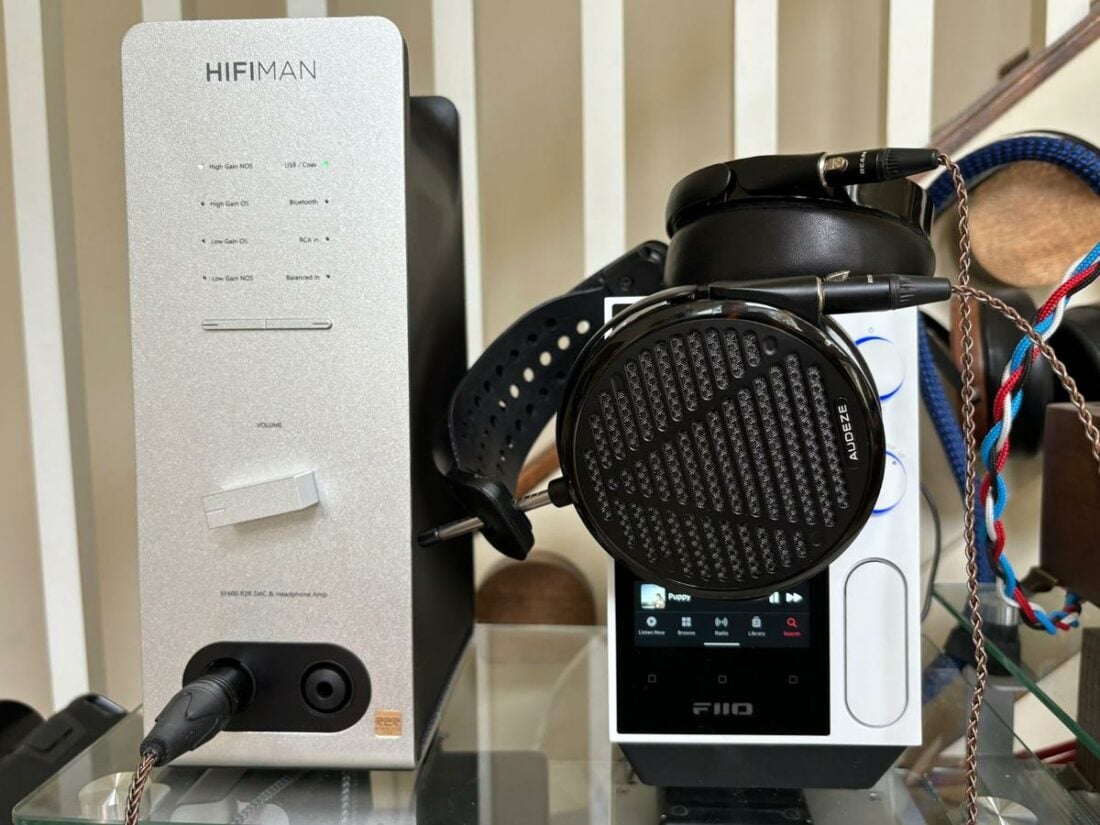
There is elegance in its simplicity, with a symmetrical arrangement on the front panel of 8 small LEDS, two buttons (source select and 2-level gain/oversampling mode), rectangular volume knob (which reminds me of vintage Yamaha amplifier controls), and 6.35mm and XLR headphone outputs.
The rear panel features a Bluetooth antenna, digital inputs (USB-a, USB-c, coaxial), balanced XLR and RCA inputs and outputs, and IEC320 power input and switch.
Thoughtfully, HiFiMan placed the heavy, toroidal transformer power supply at the bottom, keeping the unit from being tippy, and positioned integrated vents at the top and the bottom to allow for convection cooling. Again, a very smart design.
To address the elephant in the room, HiFiMan has an unfortunate reputation for sometimes questionable build quality and for some of the worst cables in the business (grrr… don’t get me started).
While the overall quality of the EF600 feels quite good, I managed to pull out one of the fixed RCA connectors from the back upon the first removal of a tight cable. Luckily, the connector is press fit, and I could bend its side tabs out slightly and pop it back in place with no lasting problems.
Additionally, I encountered some random popping noises with a few USB-c cables that work fine with other DAC/amps. Using the cable included with the FiiO R7 eliminated these noises. Still, if you jiggle the cable, the source can lose connection more easily than I encounter with other devices. YMMV.
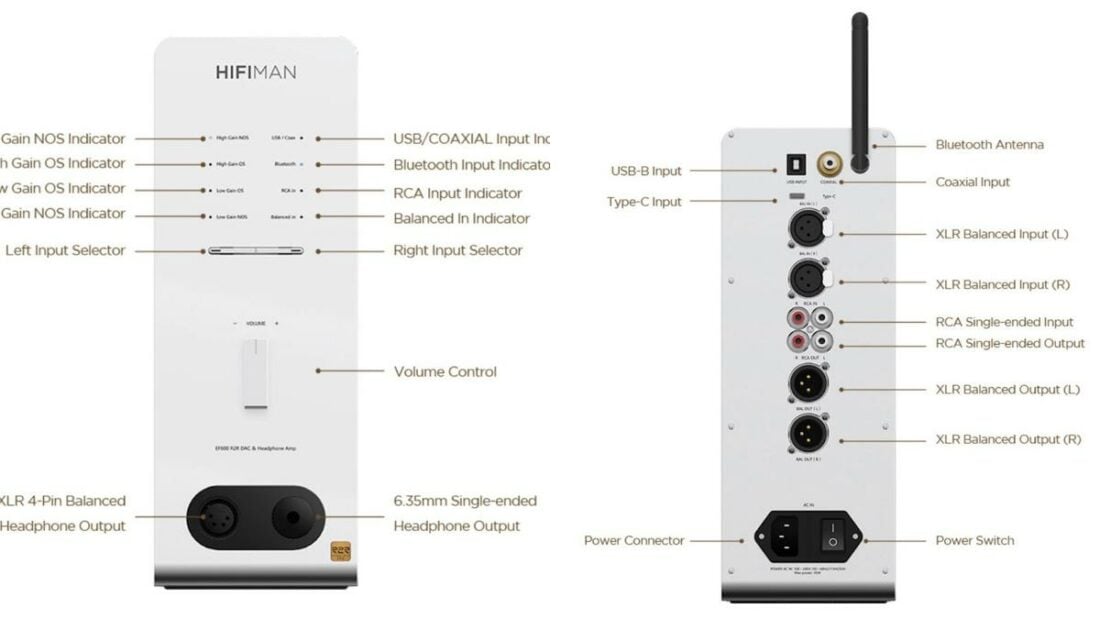
Bluetooth
The EF600 features a Bluetooth 5.0 QCC5124 chipset that supports LDAC, AptX HD, AptX, AAC, and SBC codecs. Stability and range are what I expect from a modern desktop device – which is to say, painless.
Controls
While the previously released EF400 came with four gain settings, the EF600 only allows the user to change between:
- High Gain NOS
- High Gain OS
- Low Gain OS
- Low Gain NOS
NOS (no oversampling) and OS (oversampling) digital filter modes are standard on most R-2R DACs. In this case, the OS mode up-samples all audio data to the maximum supported 768kHz sampling rate, while the NOS mode maintains the original sampling rate of the digital file.
In general, the NOS mode claims to improve phase distortion and reduce artifacts and jitter, resulting in smoother, more euphonic playback. OS mode is intended to reduce noise and improve resolution, resulting in cleaner playback with enhanced detail. Again, YMMV.
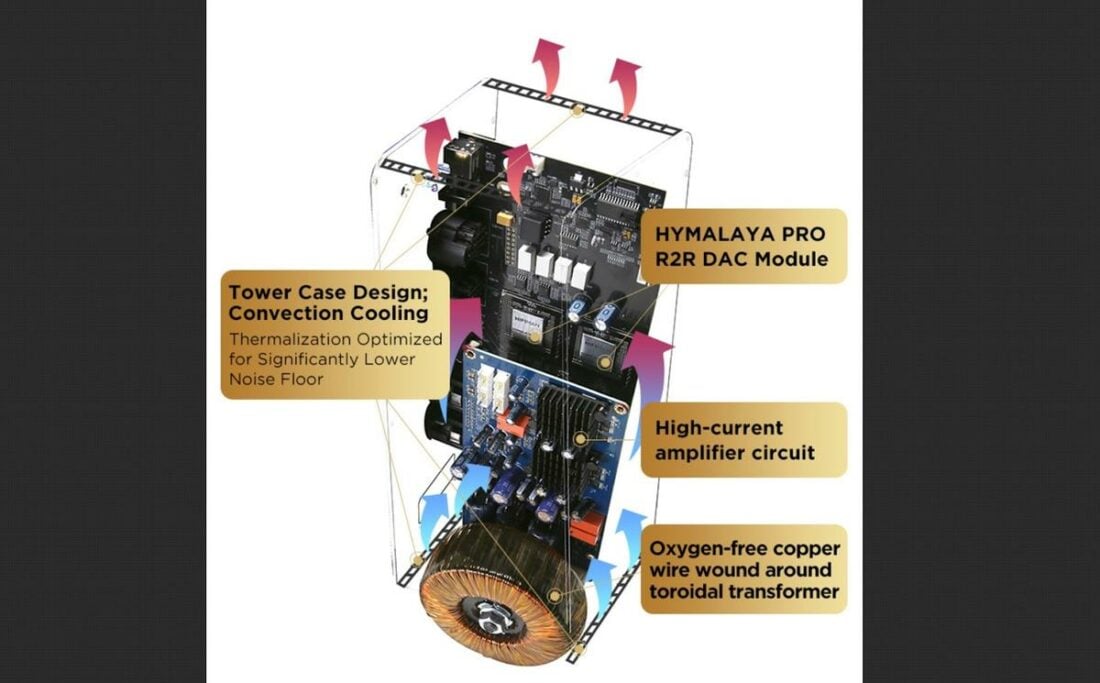
Under the Hood
The EF600 uses a dual-mono R-2R Hymalaya Pro DAC architecture capable of decoding 24-bit, 768kHz.
A resistor ladder DAC earns its R-2R name because it uses a matched pair of resistors, R and 2R (two times the R-value). An R-2R DAC must have twice the number of resistors per channel as the number of ‘bits’ being decoded. So, 24-bit decoding requires (24 x 2 = 48 x 2 channel stereo =) 96 discrete resistors.
HiFiMan’s implementation differs from that of other companies by including an FPGA chip at the heart of its R-2R DAC module, intended to reduce electrical interference, distortion, and noise.
Amplification is done in the EF600 through a fully discrete, high-current, dual-mono circuit capable of up to 5.12 W (balanced) and 1.8 W (SE).
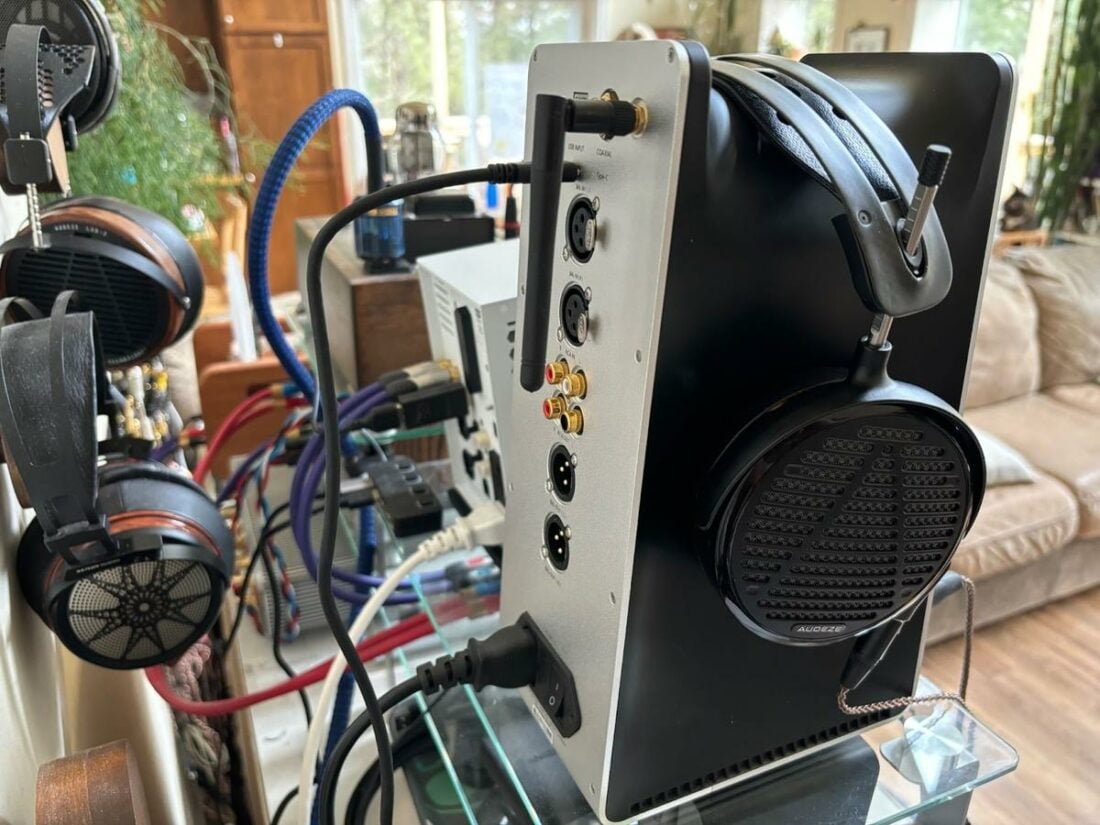
How Does the EF600 Sound?
Let’s acknowledge listener bias. Going into the review, I expected to hear a ‘different’ sounding DAC from an R-2R implementation. Something warmer, fuller, more analog-sounding. As a tube and vinyl lover, this is admittedly my wheelhouse.
In reality, I anticipate that for most folks, if you didn’t tell them something different is going on inside, they’d be hard-pressed to jump up and say, “Ah-ha, I hear those individual resistors at work!”
What listeners will hear from the EF600 is a big, powerful, and dynamic sound.
I tested it with the Audeze LCD-5 because they are ruthless listening tools and very neutral sounding – you hear what is in the music or the equipment, and the headphones don’t add or hide anything. It turns out that they are an excellent match for the EF600.
Tonality is balanced and neutral, with no loss of detail or imaging I can perceive. The key to having the LCD-5 sound their best is lots of amplifier current and the EF600 delivers. The most aggressive amplifier test in my arsenal is the remarkably inefficient HiFiMan HE6-se headphones, and the EF600 has no issues driving these just as well.
It’s a weighty, dynamic, and punchy presentation that pushes big planar drivers with aplomb.
Note that I used the balanced XLR output for more power, and dynamics do seem a touch more subdued from the 6.35 SE headphone socket.
Remarkably, with an amplifier this powerful and only two gain settings, compatibility with efficient IEMs is also quite good. At reasonable listening levels, the background is silent, with no unwanted hiss or noise. Also helping mitigate the issue is the volume taper that slowly rises for the first half of the control, allowing for fine adjustment without accidentally deafening yourself.
That said, the EF600 is intended to push HiFiMan’s line of over-ear planar magnetic headphones.
The EF600 is remarkably controlled, open, and balanced sounding. Nothing jumps out – all in all, something we reviewer types often equate with ‘musicality.’ It’s an easy-to-listen-to piece of gear that doesn’t fatigue the listener with boosted frequencies.
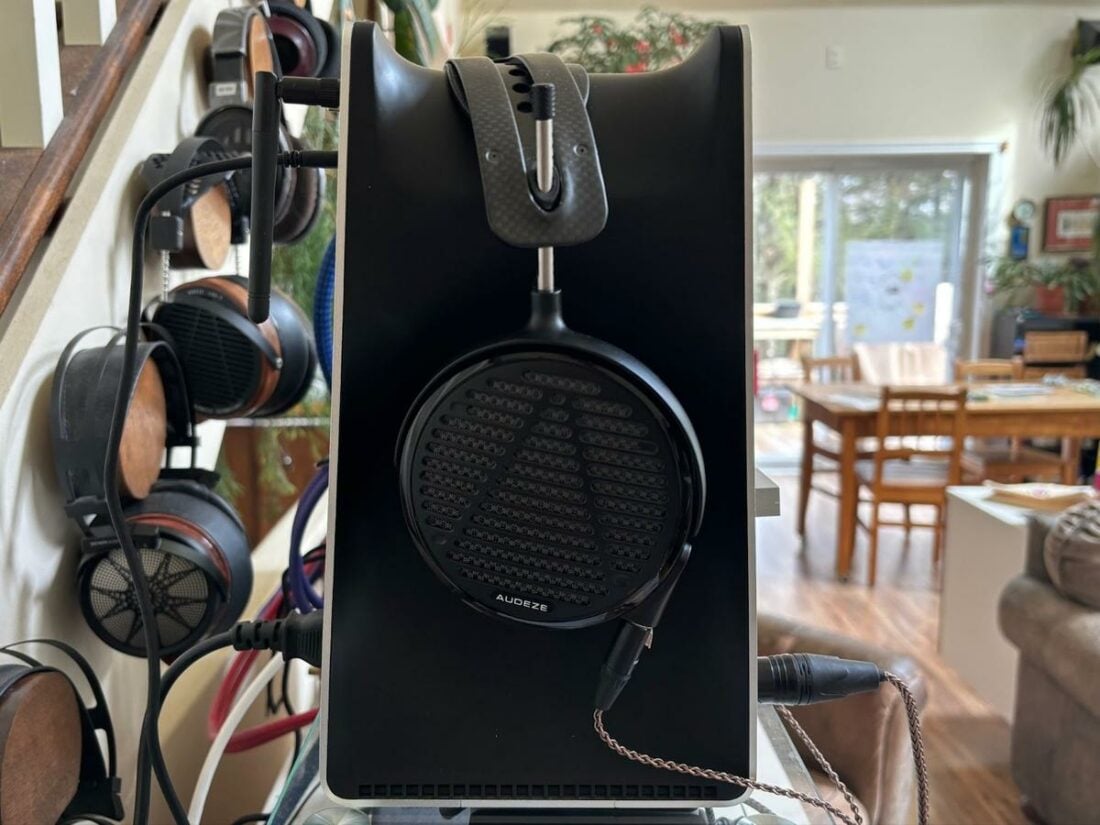
NOS vs OS
There are apparent audible differences between the NOS and OS filter modes.
NOS has a more pronounced midrange, while OS mode seems to enhance the upper frequencies and, as a result, lowers the perceived impact of the mids.
Does one sound significantly better than the other? Nope. It’s a fine adjustment to suit listener preference and headphone tonality. I *think* I prefer the ‘warmer-sounding’ NOS mode, which I tend to lean towards with R-2R DACs, but I’m perfectly happy listening to either mode.
Comparisons
The EF600 is significantly improved over the EF400 in terms of higher power output, dual-mono DAC implementation, headphone stand case design, and more IO options.
Recently, the lower-priced EF499 and EF500 DAC/amps have been released. Both are vertically oriented like the EF600 but do not have the contoured headphone stand shape and have less output power.
The 500 uses a trickle-down tech Hymalaya LE R-2R DAC, while Phillips makes the EF499 R-2R DAC. However, they are less expensive and add a network port and streaming options, which the EF600 does not have.
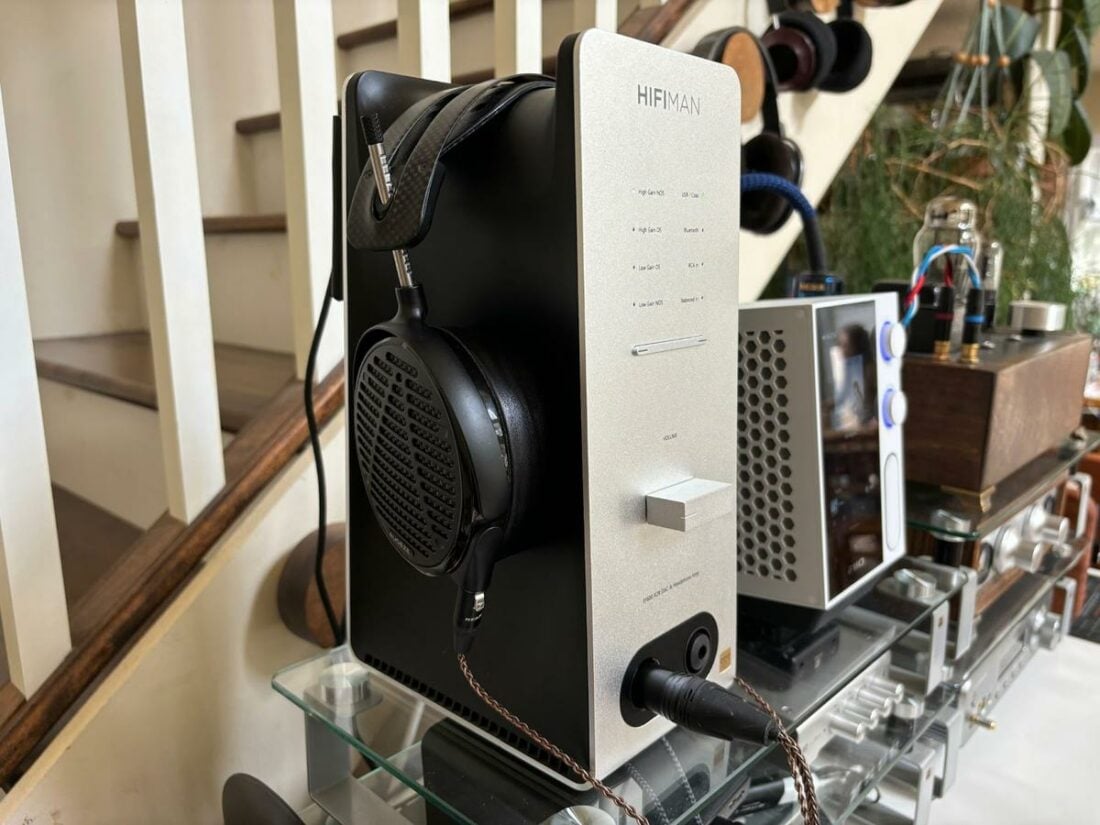
Where to Buy
Who Should Buy This?
In the USD-$500-$700 price range, the EF600 stands proud. It is a truly singular device with little direct competition. It will appeal to audiophiles wanting something unique or interested in a high-quality R-2R DAC implementation. Are your go-to cans planar magnetic monsters? The EF600 is a terrific match.
Final Thoughts
I really like what the EF600 has to offer. The further I progress in this audio hobby, the more I find myself drawn to companies pushing the boundaries and doing something different. The combined headphone stand and elegant design language speak to me. R-2R DACs and big, powerful amplifier sections are firmly on my list of ‘Pros’.
All is not perfect, however. Cost-cutting measures may be seen in the loose RCA connector, somewhat wiggly volume control, and picky USB-c connection. I understand that HiFiMan has to build to a price point and that their designs often push R&D limits and the status quo.
Still, it would be terrific if I could wholeheartedly recommend one of their products without any reservations.
Like most of HiFiMan’s products, I can confidently say the EF600 sounds terrific and offers compelling value at its price point. Many connection options and the ability to use it as a dedicated DAC for a separate headphone or full-sized stereo are greatly appreciated. The amp section is also super.
If you can overlook the few unfortunate niggles, the EF600 is well worth a listen for something truly different.
What’s in the Box?
- EF600 DAC/amp
- Power cable
- Manual
Technical Specifications
- Form: Desktop, DAC, Amp
- Chipset: 2x HYMALAYA PRO R-2R DAC
- Decoding: PCM up to 24bit/768kHz
- Frequency Response (Hz): 20Hz – 20kHz
- THD+N: 0.0014% (line-out)
- SNR: 118dB (A weighted)
- Output Power: 5.12W (balanced), 1.8W (SE) @32Ohms
- Headphone Jack: 6.35mm (SE), XLR (Balanced)
- Line Outputs: RCA, XLR
- Inputs: USB-c, USB-a, Coaxial, XLR, RCA
- Bluetooth Version: 5.0
- Bluetooth Audio Codec: LDAC, aptX, aptX HD, SBC, AAC
- Weight: 3000g
- Size: 104x165x283mm
